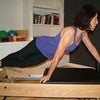Description
About This Video
Transcript
Read Full Transcript
Hi everyone. We're gonna spend 20 minutes, half an hour, just doing simple movements. I'll call them fundamental movement sequences. We're going to go down to the floor, and we're gonna play around on the floor, then we're gonna come back up. Then we're gonna go down to the floor and play around and come back up.
Over and over again in different ways. Okay? Simple things. So, let's just see you-- Few key points, I want you to land like a helicopter. Helicopters are very valuable, they land lightly.
So when you land, land lightly. So, just practice, coming down onto your knees and your feet. Try to keep your foot as square as you can, and get that weight on there. Then, down to there, and let your heels turn out, let your heels roll out. And come back up...
All the way down, and go back down. This is so good to show people, this simple movement sequence, up and down. I've got some old people and this is all they do with them, up and down, up and down, up and down. If you're finding it difficult, just slow down. If you have any problems with your knees, don't do it or slow down.
Then we're just coming up and down. Now, the next part of this is coming up, and I want you to bring a foot straight through. We want to bring it straight through, like that. We don't want it coming around like that, okay? Straight through if you can.
Push with the back toes, the back toes are up, and come forward. When you come up in life, you come up to go forward. So, come back down again, land lightly. Come all the way down. So you're all the way down, up on your toes, now bring it through.
Okay, let's try that again. Look, you need to keep the dorsiflexion on, all the way through... There. Then push, and come on up. Room for improvement.
Lets come down again, land lightly. So you're like this again. We'll try something different now. This time, cross your legs, probably use your hands to help you, I want you to roll lovingly over your lower leg, all the way down. We're going to come through, change the legs, and roll easily, slowly through that bone, that's it, land lightly, lift, change your legs, and you're really putting some weight, bone-on-bone weight, through your lower the achilles region.
Few more times. Cross, and slowly through. This is a fantastic exercise. If you had a child, and you gave this child something interesting in front, it would just roll straight through, like this, to get to it, no problems. Where as we tend not to do this transition now, so what you're doing is you're aiming for, this point-- see where my legs are crossing.
That, in acupuncture, is one of the most important points in the body. That's called spleen six, and that's where your two legs cross. It's that point that I'm encouraging you to roll on. So just try getting onto that spot, and rolling your bone, and putting some weight on it. It will hurt a bit, okay?
Use your arms to help modulate how much weight you put on it. You can just stay there, and breathe and feel it. You can avoid it, if you want, but just a little bit. They're simple movements, but they're all part of this freeing-up process that I'm trying to encourage you to do. Let's try sitting like this now.
So I call this Cowboy Posture. It's another working posture, which is why cowboys are supposedly used to sit like this. To come up from there, just turn your toes up, and stand up. Come back down onto your toes, and then go all the way down. Again, up onto your toes, and then up you come.
And back down again, and down. Let's change the legs. So we're going to come through now. So you're all the way down, so you're in sort of the Cowboy Posture, and this would be a good posture to rest in, to do the sort of things that you need to do here. If you're easy in this posture, you could spend half an hour here, easily, working.
It's quite a good posture to work on your dorsiflexion, this angle-- I encourage more of this angle in you. Without collapsing on the arch, you want to get a deep dorsiflexion. Us Westerners never get enough of this, because of the heels on our shoes. From there, come up onto the back toes, and just push on up. And back down again, and then all the way down.
Okay, we'll try it again. Up on the back toes, and come up, and down we go again, and back down. Let's try another posture, let's try some Side Saddle. So get the back heel, let the back heel, tuck it in, well the foot in, but let the heel turn out if you can. What I don't like is that.
Yeah? That's the wrong bone rhythm. I prefer that tucked in, that way.
Yeah, just a bit to the side. So we're going to practice transitioning from one side to the other, so we're gonna come up, turn the feet, and come down. Up, turn the feet, and come down. Up, turn the feet, and come down. And you're landing lightly, aren't you?
Up, and down. Up, and down. Up, and down. Up, and down. All good?
Okay, let's come to cross-legged. So, for a lot of people, a little bit of dorsiflexion, here, protects their ankles. Particularly, if you're up like this, and not from the toes, I want you to bend from the ankle, the dorsiflexion at the ankle, not just this. So a little bit of that can help. We're going to practice now, just taking-- my left leg is out, my left leg is in, and the reverse, and the reverse, and the reverse.
So, we'll just do a few more of these. It's a simple exercise. We make it a little bit more different now. I want you to really get... That.
On the outside, the little toe side, with a bit of dorsiflexion, that's the dorsiflexion, that's what we want... With a bit of dorsiflexion... With a bit of dorsiflexion... With a bit of dorsiflexion... With a bit of dorsiflexion...
See, what we're going to try and do is... Stand up. And come down. Good, okay? The trick is to get your feet right into your butt, right in low-- that! And to be on the outside of your feet, and then to come up.
Okay? And then to come back down. Look, I wouldn't do this in a general class, but you're all teachers of this sort of thing. So, you want to work on this strength, and you want to work on this ease, carrying it forward. So let's go back to that.
Forward change your legs, and roll back slowly, slowly, slowly over it again. There, slowly, slowly, slowly, and back. There, slowly, slowly slowly, change your legs, and come back. All good so far? Let's try now, coming into a squat of some sort, however you want to do it.
That's it. Probably lift your heels a little bit. That's it. So we're just going to practice now. I want you to come up, but I don't want you to stick your bottom out like that.
Kids when they go up, do it in a narrow cylinder. If they did this, they'd fall over. So they come up-- Suck your pelvic floor up, and come straight up. Down you go again. Your pelvic floor is sort of a bit open down here, so squeeze a little bit, and up you come.
And down we go again, all the way down. Squeeze your pelvic floor, and up you come. Down you go. Squeeze your pelvic floor, lower abdomen, pelvic floor, and down. Now I want you to come forward, there, and then down, and up again, and to there, and stand up.
I'll face this way, okay? Let's try now, coming down again, 'till we're all the way down, and this time, we'll come to here... Just try wriggling your bottom, side to side. Imagine you're a happy dog, side to side, wag that tail. These lateral muscles go all the way down to your sacrum.
They are the tail-wagging muscles. With your feet there a little bit turned up, so you wag your tail like a happy dog. Now, you're a frightened dog, tuck that tail under. Imagine you've got that tail and you're tucking it right under. Now take that tail right up, you're a very receptive dog.
Tail right up, okay? Tuck it right under. Imagine that tail coming right out through here somewhere, and then tuck it back up the other way. Then tuck it right under, then tuck it right up. Now bending to the side and looking behind you.
And bending to the side and looking behind you, while your feet are still up on your toes a bit. All the way over. Now we're going to come from here, watch me-- We'll come from here, to there, and land lightly. To the other side, and land lightly. The other side, and land lightly.
The landing lightly is the important part of it. All the way around. All the way around. Around. You're doing okay there?
So let's come back to the middle, and sitting like that. From here, let's come up onto here again, and try back into the squat, slowly-slowly, and again, to there. Slowly, slowly, slowly, back into the full squat, and back. Back into the full squat, and now we're gonna suck that pelvic floor, and up we come. Down we go again, and there.
And back, suck that pelvic floor up, and up you come. So you're squeezing from there and coming--- all the way down again, and we're just gonna back, landing lightly, suck that pelvic floor, and stand up. Okay, all good so far?
If you really want to work with muscles, you've got to know how to do it. We're going to bend forward with soft knees. I want your hands to be like this, functional. So just try bending forward, and soften your knees to get your hands into that posture. If you can do it with really straight legs, well then, that's okay too.
Some of you have got that range of movement. The detail at the end, look at my hands-- I want your hands looking-- I don't want this. I want functional hands, as though you were going to do a spring. So, we're coming all the way down like this. Now when you're down there, just keeping the weight on the hands, try and straighten your legs a little bit, and then relax them, and straighten them, and relax them, and straighten them.
Keep the arch of the foot, and relax it, and standing on up. Now we're gonna start to go for the hammies. So we're gonna come down, take one hand more towards one side, take the other hand up behind you to your sacrum, and as you turn, you straighten the leg of the side you're turning towards. And then relax it and come back. Change your arms.
Since I turned to the left, I was trying to straighten my left leg. As I turn to the right, I try and straighten my right leg. You should be feeling a big stretch on that hamstring. And come on up. Just try bending forward again, and you'll feel that your ability to move forward as easily has really increased.
What's nice about this stretch is you're putting the muscle-- it's an active stretch, you've got one muscle group against another muscle group, and you're talking the muscle. If you just pull a muscle it just stops. That's the end of it. To actually get it to elongate, you've got to twist it. That moves the fluid through the muscle, okay?
So, I'll just show you, the trick is-- this sort of stretching is no good, you'll pull your back muscles, well before you get to the bottom there. If you're going to do it, bend your knees and bounce. That would be alright. But for God's sake, don't get into the locked-kneed business, that's not the way to go. Bend your knees, then one hand more towards the middle, one hand up like that, right on the sacrum, as I turn to the left, I twist from my guts, twist around and straighten that left leg.
I am getting a very big stretch there now, and then the other way. Then, roll back up. So just try it once more while I watch you. So if you're turning to your left, it's your left leg you're stretching, or trying to straighten. Should be quite a big stretch on that hamstring.
I prefer your hand a bit like that, so you get that sort of twist. And then, back to the middle and just roll out of that. So we're here, we've done a bit of work stretching the hamstrings. Let's go back to the floor, land lightly, all the way down, go all the way down into this sitting one. Now, place one foot on top of the other, and I'd like you to grind that arch into the instep of the other one.
You can also dorsiflex your feet, so you really work on that grinding of one foot into the other foot. Try it on the other side. So you work into that. You can roll a bit-- You just want to explore that plantar fascia on the foot that's down. It should feel nice.
Try taking both of your legs wide, and try and get the whole foot down towards the ground, even if it's alternating it, and keep that dorsiflexion on. We don't want that. As soon as you do that, you've lost it. So keep that sensation. Now we're going to work on turning, and I want you to turn so that both your feet find the safety of the ground.
Turn the other way, and lift your pelvis. Come across, lift your pelvis. What we don't want is just this movement at the hip, that's no good. Now we're going to try this a little bit more firmly... We're going to turn and lift forward, turn and lift forward, turn and lift forward, while you keep that dorsiflexion on all the way through.
Couple more... Up, and then up, and coming back to here. And we'll come-- And the other way again, okay? And the other way, and the other way, and the other way, other way. Few more.
Okay, so we're sitting like this now. We're going to work squeezing your knees right up to each other, with a little bit of-- you're on the outside there, so you're feeling your abdominal muscles work. Relax down, squeezing your abdominal-- So as your knees come up, you're squeezing your rectus abdominis towards each other, and relax down. See these muscles are your rectus abdominis, as the muscles come down they just hit the bone and then just keep on going. They're not separate bits at all.
By the time they'd been separated with a knife, that's a bad day for you. So you're up like that, squeeze your abdominals, and relax down. Squeeze your abdominals, and down. Squeeze your abdominals, and down. Let's try changing the legs.
Squeezing these, and relaxing down. Squeezing these, and relaxing down. Squeezing these, and relaxing down. Squeezing these, and relaxing down. Squeezing them, and down.
Let's put both of our legs in front of us now. I want you to just sort of, practice, with your back upright, wriggling forward. Your back's gotta be upright for this to happen. When we go through the two- or three-day thing, I spend a lot of time on the biomechanics of how this works. So I want your back upright, and you're coming forward.
Now when you go backwards, I want you to round your back. Let it slump. So you're going backwards, and then when you run out of space, lift your back up, and roll forward. Let your legs bend a bit. Backwards, slump your back.
That's the way to do it. Forward once more. That's good. Our legs out like this now. So, just a little bit of rocking from side to side.
Try and work towards getting those feet closer towards you, get them right up, get the heels right up near your pelvic floor, bring them out and in, out, and in, out, and in, out, and in. Now, when they're right in, squeeze your muscles, and relax them down. Okay? You should really start to feel your abdominal squeeze your muscles. So this is your abdominal wall, and relax them.
Legs out, back up, going forward. Slump your back, and come backwards. Feet together, and get them right up near your pelvic floor. Now, we're going to just roll 'em, roll 'em, roll 'em roll 'em, roll 'em. Okay, and taking them wide-- So you're just stretching your legs out like this a bit.
We're going to now come across with a dorsiflexion and up into that diagonal, not with the extended hand, with the hand that's wanting to touch something out there. Come back, be careful not to lock your elbow. Coming up, reaching, but don't lock. It's a reach, but your shoulder is still part of your torso. Come back again, turn those feet with the dorsiflexion, and reaching up into that diagonal, and come back down again, landing lightly.
Up and into that diagonal. Back down. Another couple. Up, and down. And up, and down.
Cross-legged. Try this one. Two heels are sort of, more with each other now. So it's on the ground... That's it.
Is that okay for you?
Try rolling more forward, and coming back. You're trying to just open up a very low back. Now we're going to try another one. We're going to try bringing that... Right in.
Both of them. So, right in. You've got to get some momentum with it. Let the knees go out a little bit. That's it.
'Cause what we want to do is that! Then you gotta use your abdominal muscles and your knees-- but you've got to get it right in. If you're out there, you don't stand a chance. You've gotta get them right in, and then, up and standing up.
So let's just come right down into the full squat again. So, everyday for the rest of your lives, more time squatting. It's one of the most fundamental human postures. We want to get more ease in this posture. So, we're going to now, just spend a couple of minutes-- What you do at the ends is important.
You've got to make those functional hands, functional wrists, functional feet, not just funny dead things. If you do that, then the whole system behind it starts to go bad on you. So to do that, we're going to work a little bit on our toes. So come in to this posture, the Cowboy Posture, try and sit on your heel, you want to turn your heel out. Perfect.
Yeah, that's it. Come right up on your toes. Now we're going to try onto the first joint. Then we're going to try the second joint. Then come back out of it.
So, first joint, second joint, and come back out of it. First joint, second joint, and keep your ankle square. Don't let it, sickle off. Try and keep it square, and back. Let's try the other side.
So in this posture you can work on your dorsiflexion, you can really get that knee in front of the foot, which is that angle that's so important to you. Try coming up onto the toes, like that, so you've really got some weight going right through those joints. And then, we go the other way now. Support your ankle a little bit, and go for the first joint of the big toes, and then roll a little bit further to the second joint, and come back. You can-- First joint, second joint.
Be careful how much weight you put onto those toes, if they're a bit brittle. First joint, second joint. First joint, second joint. Okay. Come back into that one there.
So all of these should be softening your feet up, making them more amendable to this type of posture. We'll just come from there, cross your legs, and slowly, slowly, slowly, slowly, slowly, slowly roll your way through to there. I think that's enough for today. Thank you everyone.
It's been a pleasure to be with PilatesAnytime, and thank you for asking me. (women clapping)
Comments
me pregunto si es muy dificil incluir la posibilidad de ver los videos con subtítulos en inglés.Creo que ayudaría a muchas personas, que no tienen el ingles como primera lengua,a mejorar la comprensión y a disfrutar mas de esta fantástica página.gracias
Muscles and Meridians
You need to be a subscriber to post a comment.
Please Log In or Create an Account to start your free trial.



















































